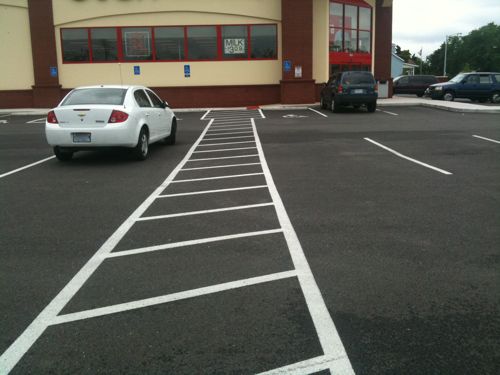Accessible Not The Same As Walkable
Walkability & accessibility are two subjects that are important to me. Ideally places would be both walkable & accessible, but that is rare. Â The minimum, for me, is accessible. Â But being accessible, ADA-compliant, isn’t remotely close to being walkable.

Walkable, in my mind, requires active tree-lined streets with generous sidewalks. Â In residential areas the buildings may be set back a bit from the sidewalk, but not too much. Â Someone on the sidewalk should be able to converse with someone on a front porch. Â Residential sidewalks should connect to a nearby commercial area no more than 1/4 mile away. Â The commercial district will have a variety of adjacent buildings all fronting onto the public sidewalk. Â Building fronts shall mostly be glass windows & doors, not blank walls. Â Public transit is available in walkable areas.
Accessible, in my mind, means a disabled person can navigate the area. Â This includes someone in a wheelchair as well as deaf or low vision/blind persons.


The CVS and Arby’s are both accessible but neither is walkable. Â Yes, someone can walk there along the accessible route but neither contributes to a walkable environment.
I reluctantly accept that not everyplace is going to be built walkable but I refuse to accept anyplace not being accessible from the public sidewalk adjacent to the property.

The Starbuck’s, above, closed after being open less than a year. Â It was drivable, but not walkable or accessible.
– Steve Patterson
Essentially, I agree. The question then becomes how do we change human behavior, especially outside of CBD's, old streetcar business districts and the few real new urbanist developments? The suburban retail model is so prevelent because the vast majority of us choose to drive and prefer to park as close as possible to the front door (when we're not using the drive-thru)!
My pet example is the retail center built on the northwest corner of Chippewa and Lindenwood Place in southwest city (http://maps.google.com/maps?f=q&source=s_q&hl=en&geocode=&q=chippewa+%26+lindenwood+pl,+st+louis,+mo&sll=38.599499,-90.298476&sspn=0.010129,0.027423&g=chippewa+%26+lindenwood+pl,+st+louis,+mo&ie=UTF8&hq=&hnear=Chippewa+St+%26+Lindenwood+Pl,+St+Louis,+Missouri+63109&ll=38.593831,-90.298476&spn=0.001266,0.003428&t=h&z=18), the one with Qdoba, Clarkson Optical and an AT&T store. It was designed to be both accessible and walkble; unfortunately, it was also designed with two equally-attractive “fronts”, one facing Chippewa and the public sidewalk and one facing the parking lot, located “appropriately” “behind” the building. The real world reality is that the “back” has become the “front”, since that's where the parking is, and the “front” doors, facing Chippewa are now locked service entrances surrounded by show windows turned into billboards for passing motorists! The opportunity was there, but for sound business reasons, all three tenants turned their backs on being “walkable”.
I'm truly stumped. Do we need to pass regulations saying you can't have convenient parking? Do we make Metro (bus and rail) “free” (no fares) so that it becomes a psychologically financially attractive option? Do we make cycling somehow cool for people of all ages? With 95%+ of us driving ourselves everywhere, the suburban model seems to work fairly well, i.e., these businesses surrounded by a sea of parking seem to be making money in spite of their not being walkable. I'm stumped . . .
The newish development at Grand & Arsenal also has a Qdoba, as well as a FedEx Office and St. Louis Bread Co. It too has parking in back. The difference is the front faces the street, the doors facing the rear parking are emergency exits only.